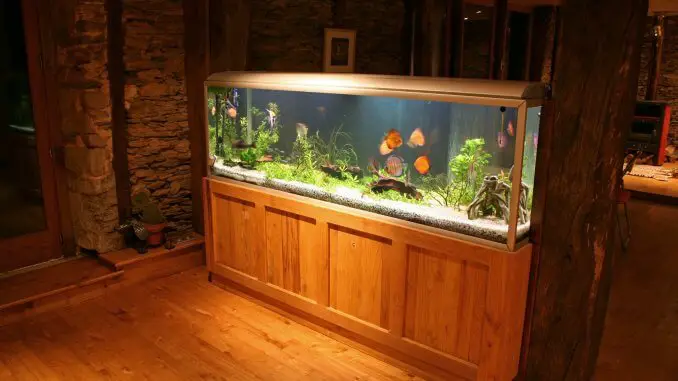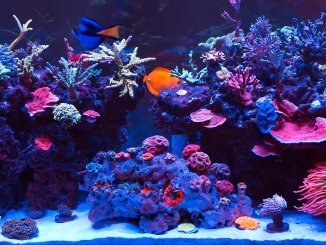
There are two main materials used for aquariums, acrylic, and glass. Unless you are an aquarium expert, you might not have wondered why what material that the aquarium is made out of is so important.
Acrylic aquariums are notoriously more expensive than glass aquariums, making some believe they are better because they are sold at a higher price. Is this really the case?
Both glass and acrylic aquariums come with their own pros and cons. You must make your decision based on the specific features you are looking for in the aquarium, and not the price point.
At first glance, you would assume the features will be pretty similar. Both can hold many gallons of water and are appropriate for aquatic plants and fish. The differences are more in the area of material durability, traditional vs. less than traditional shape, weight plus a few other points that we will cover in this review.
I am going to highlight the main features of both acrylic and glass aquariums and talk a bit about what that means for practically speaking. Meaning both materials may appear to have the same features, however, what that feature actually does for you may be completely different. Nonetheless, at the end of the article, you should have a clear opinion about what is best for you and the fish and plants you want to house.
Glass Aquariums

Clarity
Glass stays extremely clear regardless if it is a new or old tank. The great thing is, that if for some reason one side of your aquarium becomes less clear than another, you can replace that one pane.
No need to throw out the whole aquarium just because of one slightly less clear side, saving you lots of money over time. Old aquarium parts can be really useful, so if you do decide to buy a whole new aquarium, break it down into usable parts so that you always have a spare, in case something malfunctions.
Weight
Glass is very dense and heavy. The density of glass gives the aquarium a lot more presence in the room but is a complete nightmare to lift as it is so heavy.
If you are moving homes or need to transport your glass aquarium to a new location, be really careful you don’t break it along the way. Unlike acrylic aquariums, glass tanks will shatter if they are dropped. The likelihood of the glass tank falling and getting damaged in transit is much higher than with acrylic aquariums.
Even with a small glass tank, you will have to remove the water, fish, and accessories just for it to be light enough to move into another room in your house or office. What a nuisance if you ask me!
Light Distortion
The glass bends light in weird and wonderful ways, always managing to slightly distort the final image. Now add water to the equation. When viewing an object through water, like glass, it makes the object look a slightly different size or changes its shapes and angles. The combination of water and glass in a glass aquarium distorts the final image of the fish or plant quite a bit.
This process is called light refraction and overall isn’t a massive problem for home aquariums as the glass isn’t thick enough to completely obscure the look of the fish. These things are far more visible when you go to a large public aquarium with hundreds of feet worth of thick aquarium glass.
What Should You Stand the Glass Tank On?
Are you looking for an open-top aquarium? Glass tanks are the only ones sturdy and safe enough to be kept open at the top. Glass is strong and rigid, requiring less support from its stand and lid.
That being said, please do not place your tank on a stand that doesn’t offer sufficient base support. Yes, glass tanks don’t necessarily need to be placed on a stand that supports it all the way along the base, but it is advised you do so anyway. Having an unstable glass aquarium in your home is extremely dangerous because of the sheer weight of glass tanks.
Strength
The higher the water volume of the tank, the thicker the glass is going to be. Thicker glass equals a stronger aquarium. Hypothetically, if you were to knock the glass tank, drop it, or attempt to cause it any damage at all, it will show signs of weakening or even break a lot faster than an acrylic tank.
Cracks and Scratches
A glass tank doesn’t scratch very easily at all. In fact, you would have to really purposefully scratch the glass with metal or gravel for any damage to show up. Knocking the glass accidentally with a sharp or hard object may cause it to crack or even break, so be careful. Put your tank in a quiet, out of the way corner so that the fish do not get distressed and the tank won’t get bumped.
Aesthetics
Glass aquarium tanks are very limited in the shapes and designs that they come in. Most tanks are either square or rectangular, nothing too interesting and unique there.
If you purchase a curved glass aquarium you may be irritated by how much it will distort the appearance of the contents in the aquarium. So although you can find a curved glass aquarium attractive and different, it will most likely hurt your eyes if you sit and look at it for too long. Glass is very brittle and will not conform to the same shapes in the same way that an acrylic tank will.
PROS
- Doesn’t discolor over time
- Scratch resistant
- Sturdy
- More tank stand options
CONS
- Brittle
- Limited shapes available
Acrylic Aquariums

Each set includes 15 inch electrical light fixtures and aquarium reflectors with the tank. You can choose from a range of 9 tank sizes and 3 unique tank shapes. Not bad hey! Below is a breakdown of features offered to you by acrylic tanks.
Clarity
The clarity of acrylic aquariums dramatically deteriorates over the years. You will notice yellowing, scratches and an overall unpleasant looking tank after a long period of time.
This is completely normal and cannot be avoided as the chemicals in the acrylic react to a number of factors such as light (sun or artificial) as well as to any chemicals that are in the tank water.
If you feel like this will really bother you, think about the positioning of the tank and the type of fish or plants you will be growing. If the fish require long periods of bright light then this discoloration will happen much faster than if the tank was inhabited with plants and fish that thrive better under dimmer lights. The same goes for keeping the tank in direct sunlight.
Weight
The weight of the tank itself is important for those of you that are looking to move house or know you will be moving the tank into another room at some point. Acrylic tanks are about 4 or 5 times lighter than glass tanks. Slo if you are going to be lifting the tank from room to room, a lighter tank will make your life a lot easier.
It is reasonable to expect that your tank and everything in it to be with you for the next coming years, not just a few months. Anyone living in a rental property, for example, might want to consider an acrylic tank as it will be much easier to transport to a new location without breaking.
Light Distortion
When viewing an object through an acrylic panel and then through the water you will find that both objects will be distorted in a similar way. That is because water and acrylic refract light in almost the same way.
What does this mean to you? The content of your aquarium will appear significantly less distorted than if you were to view the same aquarium contents through the glass.
What Should You Stand the Glass Tank On?
What you choose to put your tank on is more important than you think. Acrylic is very flexible, which is great for preventing it from shattering or cracking upon impact. It is less reliable when there is continuous pressure on the tank.
The bottom of your acrylic tank could bend and completely separate from the rest of the tank if it isn’t supported all the way along. Think about it, all that water and substrate constantly pushing down on the acrylic will surely give way without a proper base.
Make sure the acrylic tank you purchase has a strong and sturdy lid. Do not be tempted to keep the lid off a large acrylic tank as this weakens the tank and causes the shape to change over time.
Strength
Acrylic tanks tend to be weaker than glass tanks because they are much thinner and can be bent and molded. The thickness your acrylic tank requires for a 20-gallon tank is much less than the thickness of the glass with both holding the same volume of water.
Looks can be deceiving. We have established that the acrylic tank doesn’t need to be as thick or bulky as a glass tank of the same size, and yet the thinner acrylic is just as strong as the thicker glass.
Cracks and Scratches
Acrylic is a nightmare for scratches and unexplainable marks. It is just an unavoidable part of owning an acrylic fish tank. On the other hand, you will need to try real hard to smash up your tank for it to crack or break, unlike with a glass tank.
Shock and impact are absorbed brilliantly by acrylic tanks. You will still want to keep the tank in a quiet and safe space for the safety and health of your fish. Banging on the tank and constant disturbance will frighten the fish and cause them to get depressed, lose their vibrant colors, and eventually become physically sick.
Aesthetics
If you are looking for an aquarium that is a little bit different, maybe even futuristic looking, then an acrylic tank is for you. Acrylic is a plastic and therefore is a synthetic man-made substance that can be shaped however you like.
PROS
- Moldable into many different shapes
- Shatterproof
- Flexible
- Lightweight
CONS
- Discolors over time
- Scratches really easily
Final Verdict
After weighing up the positives and negatives of both tanks, I feel like the glass aquarium tank is a much better buy in the long run. It is more sturdy and will not bend or change its shape if you have a larger tank with a higher volume of water, unlike its acrylic tank counterpart.
Glass tanks are less prone to discoloration or damage than acrylic tanks. If a glass pane breaks for any reason, that one pane can be changed, rather than having to purchase a completely new tank. You would have to completely replace an acrylic tank if a pane was damaged.
Both acrylic and glass tanks are brilliant and at the end of the day it all comes down to what you need from your tank. No matter what you go for, make sure it is reliable and from a reputable company. Have a look at the tanks we linked to in this article and see which one you like best.








Be the first to comment